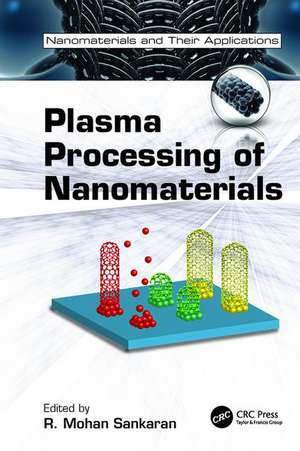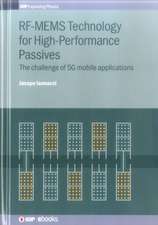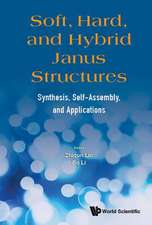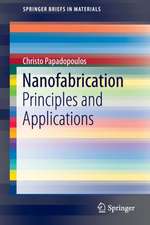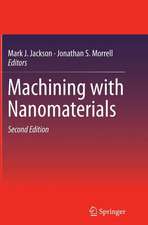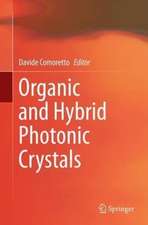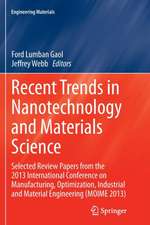Plasma Processing of Nanomaterials: Nanomaterials and their Applications
Editat de R. Mohan Sankaranen Limba Engleză Paperback – 31 mar 2017
Plasma Processing of Nanomaterials is an in-depth guide to the art and science of plasma-based chemical processes used to synthesize, process, and modify various classes of nanoscale materials such as nanoparticles, carbon nanotubes, and semiconductor nanowires. Plasma technology enables a wide range of academic and industrial applications in fields including electronics, textiles, automotives, aerospace, and biomedical. A prime example is the semiconductor industry, in which engineers revolutionized microelectronics by using plasmas to deposit and etch thin films and fabricate integrated circuits.
An overview of progress and future potential in plasma processing, this reference illustrates key experimental and theoretical aspects by presenting practical examples of:
- Nanoscale etching/deposition of thin films
- Catalytic growth of carbon nanotubes and semiconductor nanowires
- Silicon nanoparticle synthesis
- Functionalization of carbon nanotubes
- Self-organized nanostructures
Significant advances are expected in nanoelectronics, photovoltaics, and other emerging fields as plasma technology is further optimized to improve the implementation of nanomaterials with well-defined size, shape, and composition. Moving away from the usual focus on wet techniques embraced in chemistry and physics, the author sheds light on pivotal breakthroughs being made by the smaller plasma community. Written for a diverse audience working in fields ranging from nanoelectronics and energy sensors to catalysis and nanomedicine, this resource will help readers improve development and application of nanomaterials in their own work.
About the Author:
R. Mohan Sankaran received the American Vacuum Society’s 2011 Peter Mark Memorial Award for his outstanding contributions to tandem plasma synthesis.
| Toate formatele și edițiile | Preț | Express |
|---|---|---|
| Paperback (1) | 596.46 lei 6-8 săpt. | |
| CRC Press – 31 mar 2017 | 596.46 lei 6-8 săpt. | |
| Hardback (1) | 1390.92 lei 6-8 săpt. | |
| CRC Press – 19 dec 2011 | 1390.92 lei 6-8 săpt. |
Preț: 596.46 lei
Preț vechi: 701.72 lei
-15% Nou
Puncte Express: 895
Preț estimativ în valută:
114.13€ • 119.48$ • 94.44£
114.13€ • 119.48$ • 94.44£
Carte tipărită la comandă
Livrare economică 05-19 aprilie
Preluare comenzi: 021 569.72.76
Specificații
ISBN-13: 9781138077430
ISBN-10: 1138077437
Pagini: 430
Ilustrații: Approx. 60 to 70 euqations.; 11 Tables, black and white; 186 Illustrations, black and white
Dimensiuni: 156 x 234 x 22 mm
Greutate: 0.77 kg
Ediția:1
Editura: CRC Press
Colecția CRC Press
Seria Nanomaterials and their Applications
Locul publicării:Boca Raton, United States
ISBN-10: 1138077437
Pagini: 430
Ilustrații: Approx. 60 to 70 euqations.; 11 Tables, black and white; 186 Illustrations, black and white
Dimensiuni: 156 x 234 x 22 mm
Greutate: 0.77 kg
Ediția:1
Editura: CRC Press
Colecția CRC Press
Seria Nanomaterials and their Applications
Locul publicării:Boca Raton, United States
Cuprins
Nanoscale Etching and Deposition. Extreme Ultraviolet Light Lithography for Producing Nanofeatures in Next-Generation Semiconductor Processing. Nonthermal Plasma Synthesis of Semiconductor Nanocrystals. Microscale Plasmas for Metal and Metal Oxide Nanoparticle Synthesis. Large-Scale, Plasma-Assisted Growth of Nanowires. Cathodic Arc Discharge for Synthesis of Carbon Nanoparticles. Atmospheric Plasmas for Carbon Nanotubes (CNTs). Structural Control of Single-Walled Carbon Nanotubes by Plasma Chemical Vapor Deposition. Graphene Growth by Plasma-Enhanced Chemical Vapor Deposition (PECVD). Modeling Aspects of Plasma-Enhanced Chemical Vapor Deposition of Carbon-Based Materials. Modeling Catalytic Growth of One-Dimensional Nanostructures. Diagnostics of Energy Fluxes in Dusty Plasmas. Selective Functionalization and Modification of Carbon Nanomaterials by Plasma Techniques. Plasma–Liquid Interactions for Fabrication of Nanobiomaterials. Assembly and Self-Organization of Nanomaterials.
Recenzii
CRC Press author R. Mohan Sankaran is the winner of the 2011 Peter Mark Memorial Award "… for the development of a tandem plasma synthesis method to grow carbon nanotubes with unprecedented control over the nanotube properties and chirality."
—2011 AVS Awards Committee
"Readers who want to learn about how nanomaterials are processed, using the most recent methods, will benefit greatly from this book. It contains very recent technical details on plasma processing and synthesis methods used by current researchers developing new nano-based materials, with all the major plasma-based processing techniques used today being thoroughly discussed."
—John J. Shea, IEEE Electrical Insulation Magazine, May/June 2013, Vol. 29, No. 3
—2011 AVS Awards Committee
"Readers who want to learn about how nanomaterials are processed, using the most recent methods, will benefit greatly from this book. It contains very recent technical details on plasma processing and synthesis methods used by current researchers developing new nano-based materials, with all the major plasma-based processing techniques used today being thoroughly discussed."
—John J. Shea, IEEE Electrical Insulation Magazine, May/June 2013, Vol. 29, No. 3
Notă biografică
R. Mohan Sankaran is an Associate Professor of Chemical Engineering at Case Western Reserve University (CWRU) in Cleveland, Ohio. He received his Bachelor’s degree in Chemical Engineering from the University of California at Los Angeles in 1998 and his Ph.D. in Chemical Engineering from the California Institute of Technology in 2004. He joined the Department of Chemical Engineering at CWRU in 2005 as the John C. Angus Legacy Assistant Professor. As a faculty member, he has received several awards, including the CAREER Award from the National Science Foundation, the Young Investigator Program Award from the Air Force Office of Scientific Research, the Camille Dreyfus Teacher-Scholar Award, the Case School of Engineering Research Award, and the Peter Mark Memorial Award from the American Vacuum Society. He is recognized worldwide for his work on atmospheric-pressure microplasmas and their application in nanomaterials synthesis.
Dr. Sankaran received the American Vacuum Society’s 2011 Peter Mark Memorial Award for his outstanding contributions to tandem plasma synthesis.
Dr. Sankaran received the American Vacuum Society’s 2011 Peter Mark Memorial Award for his outstanding contributions to tandem plasma synthesis.
Descriere
New challenges are emerging for plasma-based processes as we shift from thin film technology to nanotechnology. Offering numerous examples of plasma processing of nanomaterials, this book provides an in-depth overview of recent advances in this crucial area, as well as threats to its development. Addressing both experimental and theoretical aspects of plasma processing technology, the author illustrates examples of its successful application in nanoelectronics, catalysis, energy sensors, nanomedicine, and several other fields.
